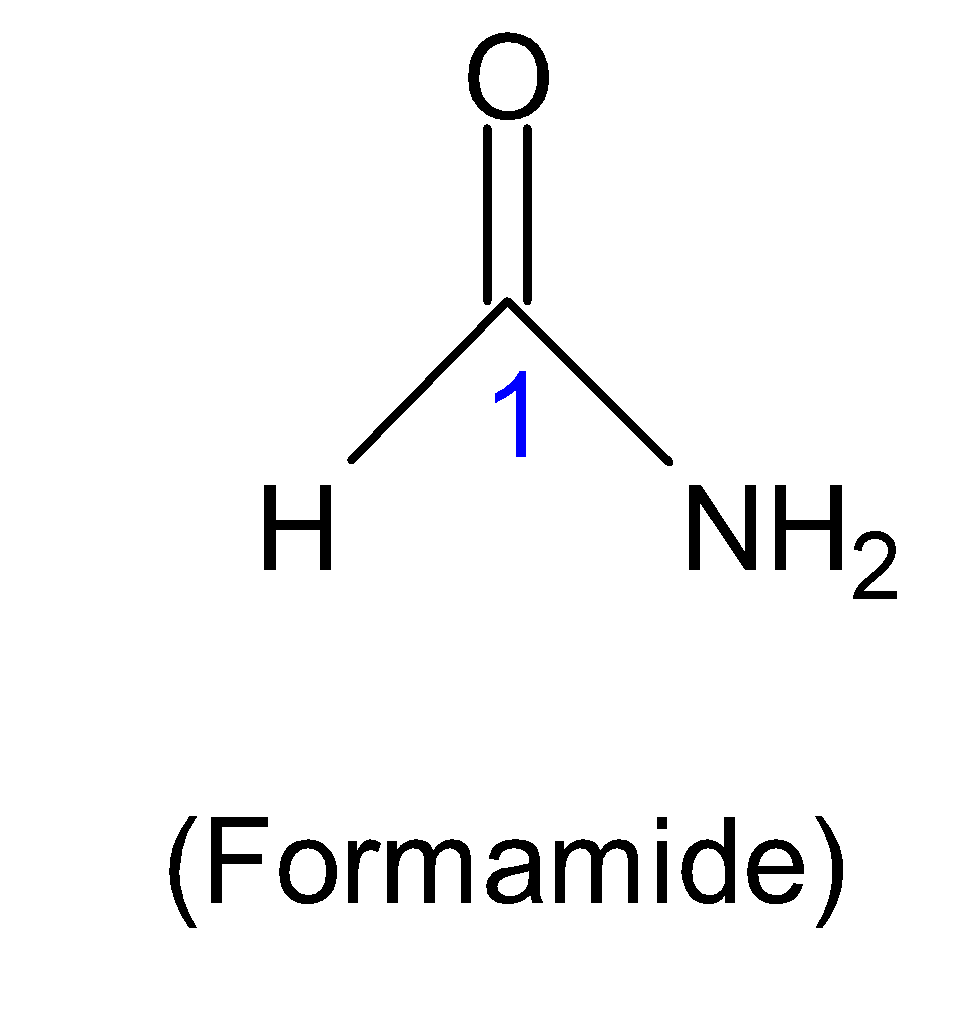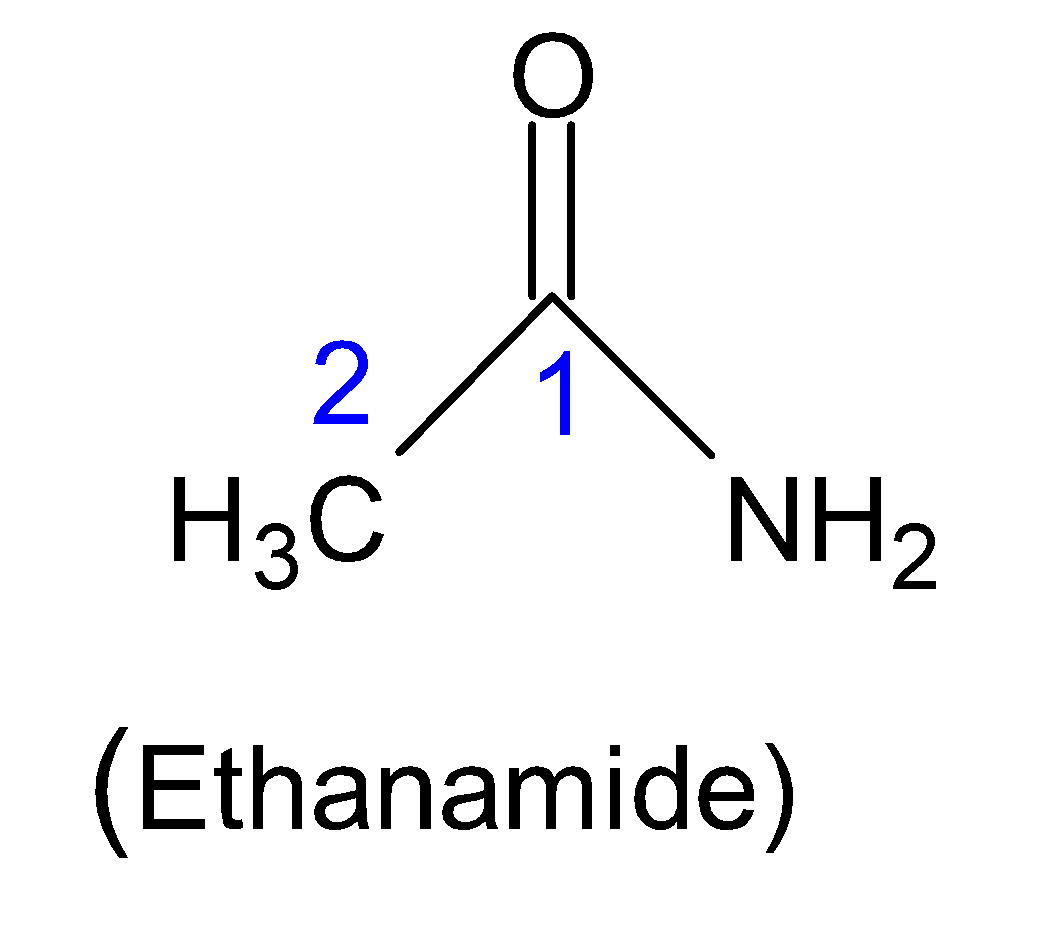
Formamide is
A.$HCON{{H}_{2}}$
B.$C{{H}_{3}}CON{{H}_{2}}$
C.$HCOON{{H}_{4}}$
D.$(HCHO+N{{H}_{3}})$
Answer
220.2k+ views
Hint: Formamide is the simplest monocarboxylic acid amide. It can be synthesized by formal condensation of formic acid and ammonia and it is functionally related to formic acid. To approach this problem we will have to the general structure of the carboxylic acid amide compound.
Complete answer:Generally, amides are derived from carboxylic acids in which the hydroxyl part $(-OH)$is replaced by $-N{{H}_{2}}$ group. For example, a general carboxylic acid, $RCOOH$reacts with ammonia, $N{{H}_{3}}$to form an amide-containing $-CON{{H}_{2}}$group.
$RCOOH+N{{H}_{3}}\to RCON{{H}_{2}}+{{H}_{2}}O$
The structure of amide is shown below:

The naming of amide is derived from the carboxylic acid by replacing the ‘’oic acid’’ ending with the word ‘’amide’’.
For example, the chemical formula of formic acid is $HCOOH$and the amide corresponding to formic acid is methanamide,$HCON{{H}_{2}}$.Similarly methanoic acid $C{{H}_{3}}COOH$and its corresponding amide are ethanamide, $C{{H}_{3}}CON{{H}_{2}}$.
As we can see over here that $-CON{{H}_{2}}$groups are present in (A) and (B), so both are compounds of amide in which (A) $HCON{{H}_{2}}$is methanamide (one carbon atom is present) or formamide and (B) $C{{H}_{3}}CON{{H}_{2}}$is ethanamide( two carbon atoms are present).


In (C) $HCOON{{H}_{4}}$is not an amide but an ammonium salt of formic acid.
When formaldehyde, $HCHO$reacts with ammonia, $N{{H}_{3}}$it forms hexamethylenetetramine, ${{(C{{H}_{2}})}_{6}}{{N}_{4}}$ popularly known as urotropine. Hence it is also not an amide compound.
$6HCHO+4N{{H}_{3}}\to {{(C{{H}_{2}})}_{6}}{{N}_{4}}+6{{H}_{2}}O$
Therefore the correct chemical formula of formamide is $HCON{{H}_{2}}$.
Thus, option (A) is correct.
Note: Formamide has many industrial chemical applications in the field of the pharmaceutical industry. It can also be used in the production of papers and can dissolve compounds and form ions, therefore it can be used as a solvent. This is a very toxic chemical to cause birth defects, so women should avoid this chemical in the early stages of pregnancy.
Complete answer:Generally, amides are derived from carboxylic acids in which the hydroxyl part $(-OH)$is replaced by $-N{{H}_{2}}$ group. For example, a general carboxylic acid, $RCOOH$reacts with ammonia, $N{{H}_{3}}$to form an amide-containing $-CON{{H}_{2}}$group.
$RCOOH+N{{H}_{3}}\to RCON{{H}_{2}}+{{H}_{2}}O$
The structure of amide is shown below:

The naming of amide is derived from the carboxylic acid by replacing the ‘’oic acid’’ ending with the word ‘’amide’’.
For example, the chemical formula of formic acid is $HCOOH$and the amide corresponding to formic acid is methanamide,$HCON{{H}_{2}}$.Similarly methanoic acid $C{{H}_{3}}COOH$and its corresponding amide are ethanamide, $C{{H}_{3}}CON{{H}_{2}}$.
As we can see over here that $-CON{{H}_{2}}$groups are present in (A) and (B), so both are compounds of amide in which (A) $HCON{{H}_{2}}$is methanamide (one carbon atom is present) or formamide and (B) $C{{H}_{3}}CON{{H}_{2}}$is ethanamide( two carbon atoms are present).


In (C) $HCOON{{H}_{4}}$is not an amide but an ammonium salt of formic acid.
When formaldehyde, $HCHO$reacts with ammonia, $N{{H}_{3}}$it forms hexamethylenetetramine, ${{(C{{H}_{2}})}_{6}}{{N}_{4}}$ popularly known as urotropine. Hence it is also not an amide compound.
$6HCHO+4N{{H}_{3}}\to {{(C{{H}_{2}})}_{6}}{{N}_{4}}+6{{H}_{2}}O$
Therefore the correct chemical formula of formamide is $HCON{{H}_{2}}$.
Thus, option (A) is correct.
Note: Formamide has many industrial chemical applications in the field of the pharmaceutical industry. It can also be used in the production of papers and can dissolve compounds and form ions, therefore it can be used as a solvent. This is a very toxic chemical to cause birth defects, so women should avoid this chemical in the early stages of pregnancy.
Recently Updated Pages
Difference Between Alcohol and Phenol: Structure, Tests & Uses

Class 12 Chemistry Mock Test Series for JEE Main – Free Online Practice

Electricity and Magnetism Explained: Key Concepts & Applications

JEE Energetics Important Concepts and Tips for Exam Preparation

JEE Isolation, Preparation and Properties of Non-metals Important Concepts and Tips for Exam Preparation

JEE Main 2021 July 25 Shift 1 Question Paper with Answer Key

Trending doubts
Understanding Centrifugal Force in Physics

JEE Main Marking Scheme 2026- Paper-Wise Marks Distribution and Negative Marking Details

Understanding Entropy Changes in Different Processes

Common Ion Effect: Concept, Applications, and Problem-Solving

What Are Elastic Collisions in One Dimension?

Understanding Geostationary and Geosynchronous Satellites

Other Pages
NCERT Solutions for Class 12 Chemistry Chapter 6 Haloalkanes And Haloarenes 2025-26

JEE Advanced Weightage 2025 Chapter-Wise for Physics, Maths and Chemistry

NCERT Solutions for Class 12 Chemistry Chapter 2 Electrochemistry

NCERT Solutions ForClass 12 Chemistry Chapter Chapter 4 The D and F Block Elements

The alcohol which gives immediate turbidity with Lucas class 12 chemistry JEE_Main

Understanding Excess Pressure Inside a Liquid Drop




